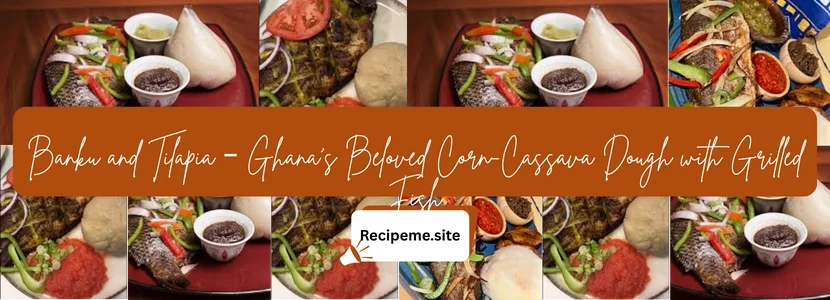
Introduction
Have you ever tasted a meal so flavorful that it felt like a story unfolding on your tongue? That’s what Banku and Tilapia (Fermented Corn-Cassava Dough with Grilled Fish) offers—a perfect harmony of sour, smoky, spicy, and savory notes.
Banku, a soft, slightly tangy dough made from fermented corn and cassava, is paired with juicy, well-seasoned grilled tilapia, often accompanied by fresh pepper sauce and vegetables. This duo isn’t just food—it’s a cultural celebration, a weekend tradition, and, for many Ghanaians, the ultimate comfort meal.
Whether enjoyed at a street-side chop bar, during family gatherings, or at a festive event, Banku and Tilapia carries a sense of home and togetherness. But how did this dish become such a cherished part of Ghanaian cuisine?
History of Banku and Tilapia
Banku’s roots trace back to Ghana’s southern coastal regions, particularly among the Ewe and Ga-Adangbe people. Traditionally, fermentation of corn and cassava dough was a preservation method that also created a distinctive tangy flavor. Over time, Banku became a staple food for households, providing sustenance and versatility.
Tilapia, on the other hand, has long been a prized fish in Ghanaian waters. Its firm texture and mild flavor made it perfect for grilling over open charcoal fires. Pairing Banku with tilapia was a natural evolution—a blend of carbohydrates and protein that balanced nutrition with unforgettable taste.
Did you know? Tilapia farming has become one of Ghana’s fastest-growing aquaculture industries, making fresh fish widely available for the beloved Banku and Tilapia combination.
Essential Ingredients
Making Banku and Tilapia requires simple, everyday ingredients—yet the result is extraordinary.
For the Banku:
-
Fermented corn dough
-
Fermented cassava dough (agbelima)
-
Water
-
Salt
For the Grilled Tilapia:
-
Fresh tilapia (whole, cleaned and scaled)
-
Garlic, ginger, onion, chili peppers
-
Seasoning cubes or bouillon
-
Salt
-
Vegetable oil
-
Lemon or lime juice
For the Pepper Sauce (Shito or Fresh Salsa):
-
Fresh tomatoes
-
Green chili peppers
-
Red onions
-
Salt
-
A dash of oil
Variations of Banku and Tilapia
While the classic Banku and Tilapia is unmatched, different regions and households put their own spin on the dish:
-
Spicy Grilled Tilapia – marinated with extra chilies for heat lovers.
-
Herb-Infused Tilapia – seasoned with fresh basil or parsley for a fragrant twist.
-
Health-Conscious Version – grilled with less oil, served with avocado and vegetables.
-
Street-Style Banku and Tilapia – served in large portions with smoky pepper sauce and cold drinks, often enjoyed outdoors.
Preparation (Step-by-Step Guide)
Cooking Banku and Tilapia at home may take time, but the process is rewarding.
Step 1: Prepare the Banku
-
Mix equal parts fermented corn and cassava dough in a pot.
-
Add water gradually while stirring until smooth.
-
Place on medium heat and stir continuously with a wooden spatula to avoid lumps.
-
Cook until thick, stretchy, and smooth.
-
Shape into rounded portions for serving.
Step 2: Marinate the Tilapia
-
Clean the fish thoroughly and make shallow cuts on each side.
-
Blend garlic, ginger, onion, and chili into a paste.
-
Rub the marinade generously inside and outside the fish.
-
Squeeze lemon juice over the fish and let it rest for at least 30 minutes.
Step 3: Grill the Tilapia
-
Preheat a charcoal grill (for that authentic smoky flavor).
-
Brush the fish with oil to prevent sticking.
-
Grill each side until golden-brown and crispy on the outside but tender inside.
Step 4: Make the Pepper Sauce
-
Blend tomatoes, chili, and onions into a smooth or chunky paste.
-
Season with salt and a drizzle of oil.
-
Serve fresh or lightly fried depending on preference.
Step 5: Serve Together
Arrange the Banku, place the grilled tilapia on the side, and add pepper sauce and vegetables. Enjoy with your hands—the traditional and most satisfying way!
Cultural Significance
Banku and Tilapia is more than just food—it’s an identity marker. In Ghana, it’s the dish that brings families together, sparks laughter at weekend gatherings, and symbolizes hospitality when shared with guests.
It’s also a social equalizer. From street vendors to upscale restaurants, everyone enjoys Banku and Tilapia. It’s a dish that bridges class divides and unites people over a shared love of flavor.
Serving Suggestions
-
Pair with freshly sliced onions and green bell peppers for crunch.
-
Serve with shito (black chili sauce) for a deep, smoky spice.
-
Add avocado slices for a creamy balance.
-
Enjoy with a cold beverage—many Ghanaians love pairing it with soft drinks or palm wine.
Types of Banku and Tilapia
While there’s essentially one main dish, the types are usually defined by the accompaniments and preparation styles:
-
Classic Banku and Tilapia – grilled fish with fresh pepper.
-
Deluxe Version – served with shito, salad, and avocado.
-
Street Vendor Style – smoky grilled tilapia, extra-hot sauce, and generous Banku portions.
Tips for Perfect Banku and Tilapia
-
Stir Banku continuously to avoid lumps—it requires patience and strength.
-
Always marinate the fish for at least 30 minutes for deeper flavor.
-
Charcoal grilling enhances authenticity—avoid overcooking to keep fish juicy.
-
Balance the sourness of Banku with spicy or tangy pepper sauce.
Did you know? In Ghana, it’s common to eat Banku and Tilapia with your hands—locals believe it makes the meal taste even better!
Other Valuable Information
Banku and Tilapia is not just popular in Ghana—it’s gaining recognition in African restaurants worldwide. Many food enthusiasts in Europe and the US seek it out as an introduction to authentic Ghanaian cuisine.
Nutritionally, Banku provides energy-rich carbohydrates while tilapia supplies lean protein and essential omega-3 fatty acids, making it a well-rounded dish.
Personal Experience / Journey of Discovery
The first time I had Banku and Tilapia was at a lively roadside eatery in Accra. The smoky tilapia arrived hot off the grill, its skin crispy and its flesh juicy. The Banku was soft yet firm, tangy yet satisfying. Paired with fiery pepper sauce, it was a flavor explosion I’ll never forget.
More than the taste, it was the atmosphere—the laughter of diners, the sizzling of fish on open flames, the warmth of sharing food—that made the experience unforgettable. Banku and Tilapia wasn’t just a meal; it was a celebration of life itself.
A Reflective Closing
Banku and Tilapia is a dish that tells Ghana’s story—its traditions, its resourcefulness, and its love for food that brings people together. Each bite is a reminder of heritage and a taste of home, whether you’re in Ghana or abroad.
So, the next time you crave a meal that’s both hearty and soulful, try Banku and Tilapia. It’s not just food—it’s Ghana on a plate.
Frequently Asked Questions
1. What is Banku made of?
Banku is made from fermented corn dough and cassava dough, cooked together into a smooth, stretchy consistency.
2. Can I make Banku without cassava?
Yes, but the cassava adds elasticity and enhances texture. Without it, the Banku may be firmer.
3. How long does it take to prepare Banku?
Banku itself takes about 20–30 minutes to cook once the dough is ready. Fermentation of the dough, however, may take 2–3 days.
4. Is Banku and Tilapia healthy?
Yes! Banku provides carbohydrates, while tilapia offers lean protein and omega-3s. Paired with fresh pepper and vegetables, it’s a balanced meal.
5. Why is Tilapia grilled instead of fried?
Grilling enhances the smoky flavor and keeps the fish healthier, with less oil.
6. How is Banku traditionally eaten?
Banku and Tilapia are traditionally eaten with the hands, making the experience more authentic and communal.
